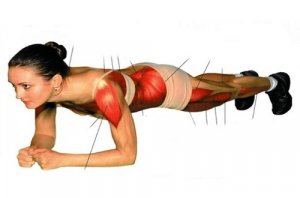The Benefits of Doing Planks for Your Abs and Body


Reviewed and approved by the doctor José Gerardo Rosciano Paganelli
You probably know that the key to a healthy weight and slim figure is a good exercise routine. Exercise can help target specific areas while giving your body energy to burn extra calories. Those are the benefits of doing planks. But thanks to a lack of time, difficulty, or personal preference, many opt not to exercise on a regular basis. As a result, they miss out on the kind of physical activity they need to stay healthy. And although there are many benefits of doing planks, many skip out on them. Find out more about planks and how you can target various parts of your body.
If regular exercise isn’t for you, there’s an option that can help you lose weight and stay healthy. People around the world are learning about the benefits of doing planks and why they’re so effective. They focus on working your core muscles while targeting other muscle groups. This makes it ideal for weight loss.
To see results from planks, all you need is the willpower to keep at it. You need to do this exercise every day, at least once a day, for several minutes. However, it’s not an easy exercise. Indeed, you have to work at supporting your body weight using only your hands and feet for several minutes in a row. But by holding this position, you’ll activate many muscle groups. As a result, you can get a stronger back, shapely legs, flat abs, toned arms, and toned glutes with less cellulite.
The how-to guide to planks

Planks are a static form of exercise. As such, you’re required to hold your body in the same position for a given amount of time. What’s more, you have to do so without moving.
Firstly, lie face down on the floor. Then, bend your elbows to a 90-degree angle so they’re aligned with your shoulders. Your body should form a straight line from your head to your heels. Moreover, you should support yourself using only your forearms and toes. Finally, keep in mind that your elbows should be directly below your shoulders.
In addition, to hold this position, you’ll need to tighten your abdominal muscles and avoid relaxing them. Your hips should stay high in the air and you’ll have to hold the position for several minutes. At first, you can start with one or two minutes. But the idea is to increase your endurance and little by little reach five or more minutes at a time.
- Feet: You may find it difficult to keep your balance, so use your abs to help you.
- Legs: They should be straight and together, to keep the pressure on your core and the lower part of your spine.
- Glutes: Your glutes should remain tight throughout this exercise since they activate many muscle groups in the lower part of your torso.
- Lower back: This part of the body is very important for the successful completion of this exercise. Your lower back should remain straight. Under no circumstances should it curve – imagine it pressing firmly against a wall.
- Abdomen: The entire exercise should tighten your abdominal muscles so that you feel pressure, but don’t hold your breath.
- Elbows: Your elbows should be underneath your shoulders, forming a straight line to keep from straining them.
Find out more: Do these 5 Exercises to Get Bigger Glutes Quickly
Tips for beginners
The idea behind planks is to hold the position as long as you can. The benefits of doing planks are incredible which makes up for their difficulty. If you’re not used to exercising often and want to start this routine, start by holding each plank for 10 to 15 seconds. If you exercise regularly, you can start with up to two minutes. Then you can take a break and do up to five reps.
If you’re a beginner, don’t try to break any records anytime soon. Remember to increase your time steadily, until you can hold this position for several minutes without a problem.
The benefits of doing planks
- Toned glutes: This exercise works your glutes and hamstrings. As a result, it helps tone your butt and also helps fight cellulite.
- Stronger back: The plank works the muscles in your back, neck, and shoulders. It’s great for preventing future problems in your neck and lower spine. It’s also a good way to relax your back muscles after heavy lifting.
- Toned legs: You might feel a slight burning sensation in your legs while doing this exercise. Don’t worry – that means you’re doing it right.
- Flat belly: This position forces the side and lower abdominal muscles to contract and tone.
All cited sources were thoroughly reviewed by our team to ensure their quality, reliability, currency, and validity. The bibliography of this article was considered reliable and of academic or scientific accuracy.
- Tvrdy, D. (2012). The reverse side plank/bridge: An alternate exercise for core training. Strength and Conditioning Journal. https://journals.lww.com/nsca-scj/fulltext/2012/04000/The_Reverse_Side_Plank_Bridge___An_Alternate.15.aspx
- Boren, K., Conrey, C., Le Coguic, J., Paprocki, L., Voight, M., & Robinson, T. K. (2011). Electromyographic analysis of gluteus medius and gluteus maximus during rehabilitation exercises. International Journal of Sports Physical Therapy. https://www.ncbi.nlm.nih.gov/pmc/articles/PMC3201064/
- Fong, S. S. M., Tam, Y. T., Macfarlane, D. J., Ng, S. S. M., Bae, Y. H., Chan, E. W. Y., & Guo, X. (2015). Core Muscle Activity during TRX Suspension Exercises with and without Kinesiology Taping in Adults with Chronic Low Back Pain: Implications for Rehabilitation. Evidence-Based Complementary and Alternative Medicine. https://www.hindawi.com/journals/ecam/aa/910168/abs/
- Chan, M. K., Chow, K. W., Lai, A. Y., Mak, N. K., Sze, J. C., & Tsang, S. M. (2017). The effects of therapeutic hip exercise with abdominal core activation on recruitment of the hip muscles. BMC musculoskeletal disorders, 18(1), 313. https://bmcmusculoskeletdisord.biomedcentral.com/articles/10.1186/s12891-017-1674-2
- Vera-Garcia, F. J., Barbado, D., Flores-Parodi, B., Alonso-Roque, J. I., & Elvira, J. L. L. (2016). Activación de los músculos del tronco en ejercicios de estabilización raquídea/Trunk muscle activation in spine stabilization exercises. Revista Internacional de Medicina y Ciencias de la Actividad Física y del Deporte, (52). https://revistas.uam.es/rimcafd/article/view/3934
This text is provided for informational purposes only and does not replace consultation with a professional. If in doubt, consult your specialist.








